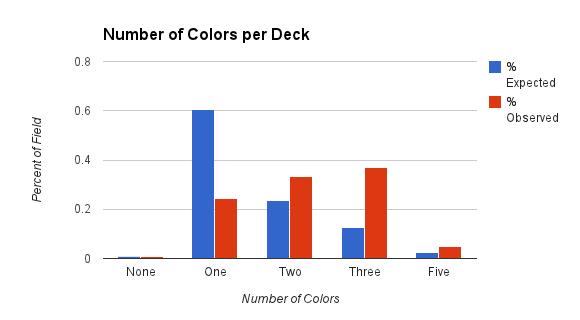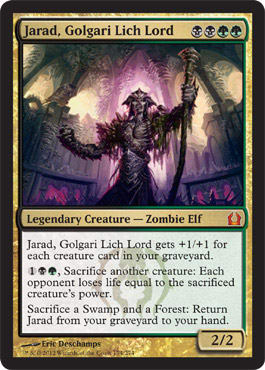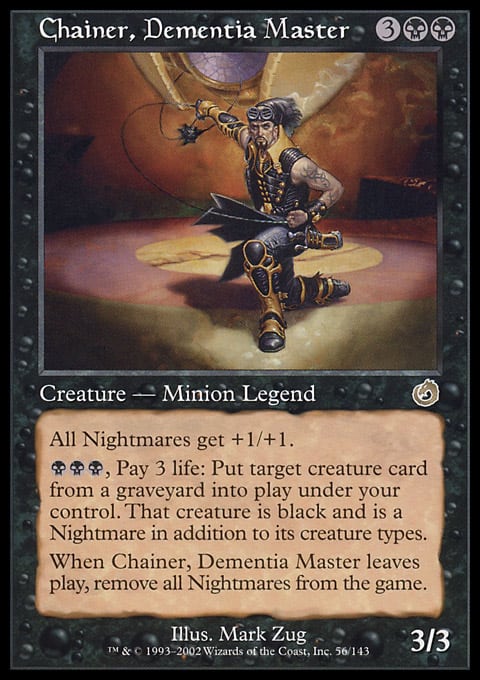About fifteen months ago, Devon Rule wrote an article titled “1,000 Commander Decks” to take a look at the top commanders and colors in the format. I thought it’d be fun to take a look at the final data and see if anything’s changed since then.
The Most Popular Commanders of 2012
Devon hosted a thread titled “Most Popular Commanders 2012” and kept it open from January 1 until December 31, 2012 on the official Commander forums. Readers were invited to list the decks they played regularly along with any regular decks from their playgroups. In December, Devon started an additional thread on the Commander forum at MTGSalvation. The threads ultimately collected four hundred eight-five responses and three thousand two hundred ten decks. It was a huge response, but since readers were invited to comment instead of being randomly sampled, it’s likely the data are significantly biased, especially against casual players who don’t spend much time hanging out on forums. So, any results have to be taken with a grain of salt. Still, in the same way tournament data says a lot about committed tournament players, Devon’s survey says a lot about committed Commander players, which makes it a valuable resource for trying to describe the global Commander metagame.
I can hear a few readers out there asking, “Hey, wait; it’s July. Isn’t this old news?” The short answer is, “Nope!” Since the global Commander game moves slowly compared to the other formats, the odds are good the format hasn’t changed much since the end of 2012.
Top 11 Most Popular Commanders
While Devon listed the Top 10 commanders in the original article, there were a few ties that made it sensible to look at the Top 11 instead. I’ve also included their percentages of the metagame because it illustrates a key point below.
| General | Number of Decks | Percent of Total |
|---|---|---|
| 1. Kaalia of the Vast | 72 | 2.25% |
| 2. Karador, Ghost Chieftan | 68 | 2.12% |
| 3. The Mimeoplasm | 68 | 2.12% |
| 4. Ghave, Guru of Spores | 62 | 1.94% |
| 5. Riku of Two Reflections | 58 | 1.81% |
| 6. Sharuum the Hegemon | 56 | 1.75% |
| 7. Zedruu the Greathearted | 55 | 1.72% |
| 8. Edric, Spymaster of Trest | 52 | 1.62% |
| 9. Animar, Soul of Elements | 49 | 1.53% |
| 10. Mayael the Anima | 44 | 1.38% |
| 10. Niv-Mizzet, the Firemind | 44 | 1.38% |
| Total Percent of Metagame | 19.62% |
The biggest changes were Kaalia claiming the top spot, Sharuum finishing in sixth, and Niv-Mizzet tying with Mayael. Their gains came at the expense of green commanders and were largely the result of MTGSalvation responses (remember that the survey didn’t open there until December), so there probably wasn’t a big change between April 2012 (when Devon’s original article was published) and December 2012 (when the survey closed). At first glance, it appears the precon commanders were still the most popular choices.
Top 11 Most Popular Commanders (Excluding Precons)
| General | Number of Decks | Percent of Total |
|---|---|---|
| 1. Sharuum the Hegemon | 56 | 1.75% |
| 2. Mayael the Anima | 44 | 1.38% |
| 2. Niv-Mizzet, the Firemind | 44 | 1.38% |
| 3. Glissa, the Traitor | 42 | 1.31% |
| 4. Thraximundar | 39 | 1.22% |
| 5. Rafiq of the Many | 38 | 1.19% |
| 6. Grimgrin, Corpse-Born | 36 | 1.13% |
| 6. Olivia Voldaren | 36 | 1.13% |
| 7. Jarad, Golgari Lich Lord | 32 | 1.00% |
| 8. Child of Alara | 31 | 0.97% |
| 8. Omnath, Locus of Mana | 31 | 0.97% |
Jor Kadeen, the Prevailer, Rith, the Awakener, and Kresh the Bloodbraided were booted from the top nonprecon commanders and replaced by the above-mentioned Niv-Mizzet along with Rafiq of the Many and the upstart Jarad, Golgari Lich Lord. The newcomers were joined by Child of Alara, who tied with Omnath. As with the precon commanders, most of these adjustments were caused by including responses from MTGSalvation and probably weren’t changes in popularity through the year. (The obvious exception is Jarad, who didn’t exist when Devon wrote the original article.)
The reason I included the percent of the total is that I want to show just how narrow the difference between the top commanders really is. Not only are the top commanders all within a fraction of a percent of each other, the difference between Kaalia at number one and Angus Mackenzie down at one hundred one is a little over 1% of the field. If Devon had run this survey a dozen times, we could easily have seen a dozen different “top” commanders.
The other point is that, even considered collectively, the “top” decks are a small part of the overall metagame (especially compared to sixty-card formats). Ever since the precons were released, there’s been grumbling from old-timers that transitioning from EDH to Commander somehow spoiled the originality of the format and that new players are only playing cookie-cutter decks. The data suggest this is wrong. While the precon commanders make up most of the top ten, the top ten decks make up less than 20% of the metagame, and even looking at the top fifty Commanders still only makes up 52% of the metagame.

In fairness to the grumblers, there’s a good chance the survey underestimates the precons’ presence—the players who didn’t see the survey are probably more likely to be playing a precon deck. Given that the top commanders are such a tiny portion of the field, though, the precon commanders could be dramatically underrepresented (even by two to three hundred percent) and still be a small part of the landscape.
One more fun fact: Not only are players running a broad spread of decks, they aren’t even close to using all of the options available. Out of four hundred seventy-two legendary creatures in 2012, only three hundred twenty-nine were represented, leaving one hundred forty-three commanders unplayed. Furthermore, out of the three hundred twenty-nine commanders present, one hundred seven were used by just one or two players. Many of those underused commanders are terrible cards from Legends or Portal Three Kingdoms, but there are probably some forgotten all-stars too.
Decks by Color
In his original article, Devon examined colors the same way as individual commanders (as a percent of the total decks in the survey). There’s a problem with this approach, though. Legendary creatures aren’t evenly distributed; white and black have substantially more legendary creatures than the other colors. To control for the disparity between colors, I created an expected-value measure for a color or color combination’s popularity. I figured the proportion of a color/color combination out of all four hundred seventy-three available commanders in 2012 to use as the percent of the field expected, compared that figure to the proportion of the field observed in Devon’s data, and used the difference between the expected value and the observed value as a gauge of their popularity.
Think about it this way: Assuming everyone picked a commander at random, the colors would show up roughly in proportion to the number of legendary creatures printed in those colors. In other words, if mono-black legends are 14% of the total number of legendary creatures, in a large group of players picking commanders at random, roughly 14% of those players would end up with mono-black legendary creatures.
In the real world, most players don’t pick commanders at random, so if there’s a substantial difference between how often we expected a color to show up and how often it actually showed up in the survey, there’s a good chance there’s something affecting that color’s popularity.
Using the chart below as an example, since there were two hundred eighty-seven mono-colored legendary creatures out of four hundred seventy-three total legendary creatures available in the game in 2012, we would expect about 61% of the decks in the survey to be mono-colored. Looking at the survey results, however, there were seven hundred seventy-six mono-colored decks out of three thousand two hundred ten decks surveyed, so mono-colored decks were about 24% of the observed metagame. As it turns out, mono-colored decks are only about 40% as popular as expected.
Number of Colors per Deck
| Number of Colors | Commanders w/ Number of Colors | % of Total Commanders
(expected) |
# of Commanders Surveyed | % Surveyed Commanders (observed) | % Difference (popularity) |
|---|---|---|---|---|---|
| Zero | 4 | 00.85% | 22 | 00.69% | 81.18% |
| One | 287 | 60.68% | 776 | 24.18% | 39.85% |
| Two | 111 | 23.47% | 1067 | 33.24% | 141.6% |
| Three | 60 | 12.69% | 1187 | 36.98% | 291.4% |
| Five | 11 | 2.33% | 158 | 4.93% | 211.6% |
What makes comparing the observed and expected percentages cool is that it highlights how unpopular mono-colored decks are. In the original article, Devon was surprised at how popular mono-colored decks are. Considering that a substantial majority of commanders are multicolored, it’s actually surprising how few of those commanders are being played.
Two-colored decks also remain popular, but despite introducing a couple popular new commanders, Return to Ravnica doesn’t seem to have shifted the metagame much. By the end of 2012, there were only slightly more two-colored decks than back in April 2012, when Devon found that two-colored decks were about 31% of the field.
Colorless and five-colored decks are a little tricky to say anything meaningful about. Since they’re such a small part of the total field, their observed percent is probably within the guesstimated margin of error of the survey, and in all likelihood, they show up about as often as expected. This is a little clearer in a different form:

In other words, even though there’s a substantial percent difference between the expected and observed values, the values are really small to begin with, so there might not be much difference after all.
Decks Containing a Color
| Color | Commanders per Color | % of Total Commanders
(expected) |
# of Surveyed Commanders | % of Surveyed Commanders (observed) | % Difference (popularity) |
|---|---|---|---|---|---|
| White | 144 | 20.94% | 1248 | 19.23% | 91.84% |
| Blue | 133 | 19.34% | 1348 | 20.78% | 107.4% |
| Black | 151 | 21.95% | 1380 | 21.27% | 96.91% |
| Red | 130 | 18.90% | 1200 | 18.49% | 97.84% |
| Green | 131 | 19.05% | 1314 | 20.25% | 106.3% |
Since the percentages are pretty close again, let’s skip right to the bar chart:

Keep in mind that this is the super-up-close view (there are only 4 points of difference between the bottom and top of the chart). Still, it appears that white is significantly less popular than we’d expect, and green and blue are disproportionately more popular than expected.
One quirk: While red shows up pretty much as expected, I suspect it’s a little overstated because of how popular Norin the Wary is with the Salvation community.
Most Popular Color Combinations
| Color Combination | Commanders per Combo | % of Total Commanders (expected) | # of Surveyed Commanders | % of Surveyed Commanders
(observed) |
% Difference (popularity) |
|---|---|---|---|---|---|
| 1. Junk (B/G/W) | 4 | 0.85% | 182 | 5.67% | 667.1% |
| 2. B/U/G | 3 | 0.64% | 115 | 3.59% | 560.9% |
| 3. R/U/G | 4 | 0.85% | 151 | 4.71% | 554.1% |
| 4. W/B/R | 3 | 0.64% | 96 | 3.00% | 468.8% |
| 5. Simic (G/U) | 3 | 0.64% | 93 | 2.90% | 453.1% |
| 6. Patriot (R/W/U) | 3 | 0.64% | 81 | 2.53% | 395.3% |
| 7. Izzet (U/R) | 5 | 1.06% | 108 | 3.37% | 317.9% |
| 8. Orzhov (W/B) | 4 | 0.85% | 73 | 2.28% | 268.2% |
| 9. Naya (R/G/W) | 7 | 1.48% | 115 | 3.59% | 242.6% |
| 10. Boros (R/W) | 6 | 1.27% | 93 | 2.90% | 228.4% |
| 11. Bant (G/W/U) | 8 | 1.70% | 120 | 3.74% | 220.0% |
| 12. Five-Colored | 11 | 2.33% | 158 | 4.93% | 211.6% |
| 13. Esper (W/U/B) | 10 | 2.12% | 137 | 4.27% | 201.4% |
| 14. Golgari (B/G) | 11 | 2.33% | 146 | 4.55% | 195.3% |
| 15. Grixis (U/B/R) | 10 | 2.12% | 115 | 3.59% | 169.3% |
| 16. Jund (B/R/G) | 8 | 1.70% | 75 | 2.34% | 137.6% |
| 17. Dimir (U/B) | 17 | 3.60% | 129 | 4.02% | 111.7% |
| 18. Azorius (W/U) | 17 | 3.60% | 124 | 3.87% | 107.5% |
| 19. Rakdos (B/R) | 16 | 3.39% | 112 | 3.49% | 103.0% |
| 20. Gruul (R/G) | 14 | 2.96% | 86 | 2.68% | 90.6% |
| 21. Selesnya (G/W) | 18 | 3.81% | 103 | 3.21% | 84.3% |
| 22. Colorless | 4 | 0.85% | 22 | 0.69% | 81.2% |
| 23. Blue | 53 | 11.2% | 175 | 5.46% | 48.7% |
| 24. Red | 54 | 11.4% | 168 | 5.24% | 45.9% |
| 25. Black | 65 | 13.8% | 181 | 5.64% | 41.0% |
| 26. Green | 51 | 10.8% | 128 | 3.99% | 37.0% |
| 27. White | 64 | 13.5% | 124 | 3.87% | 28.6% |
Assembling this into a bar graph is a mess, so I’m afraid you are stuck reading the chart. The color-combinations table has the greatest disparity between measuring popularity with my method and looking at the raw number of commanders (which was Devon’s original method):
Most Popular Colors (Devon’s method)
- B/G/W: 182
- Black: 181
- Blue: 175
- Red: 168
- Five-Colored: 158
- R/U/G: 151
- Golgari: 146
- Esper: 137
- Dimir: 129
- Green: 128
. . .
- Jund - 75
- Orzhov - 73
- Colorless - 22
As it turns out, the B/G/W (junk/Necra) wedge wins by both measure.
The other results are very different. As I mentioned above, though, I don’t think looking at the most frequently occurring colors says anything descriptive about the format. Looking at mono-black, for example, its one hundred eighty-one commanders sounds impressive. Once you remember that 14% of legendary creatures in the game are black, though, it sounds a lot less impressive; for black to meet that expectation, there would need to be almost four hundred fifty mono-black decks in the survey. Considered as a whole, the mono-colored commanders apparently leave a lot to be desired. And while knowing that mono-black is a widely played color choice is a fun piece of trivia, how often is that info useful? You probably already know what color hate is useful in your local metagame, and if you’re prepping for a Commander tournament, you’re probably looking for ways to beat proven strategies instead of random decks.
One interesting trend in the data is that the more commanders there are in a color, the less popular that color appears. I think this is partly explained by how old the commanders in those colors are. Mono-colored and allied two-colored legendary creatures have been around almost since the beginning of the game, which hurts their relatively popularity because they’re burdened with a lot of older, weaker creatures. Meanwhile, most enemy two-colored commanders didn’t show up until Ravnica: City of Guilds, and the first wedge commanders were the Planar Chaos Dragons. So, there aren’t many commanders in those colors, and the few available are newer, stronger creatures. Color age also helps explain why Golgari is the least popular enemy dual-colored deck (Vhati il-Dal and Iname as One drag its popularity down). This also helps explain similarly why the shards tend to be less popular than the wedges when comparing tri-colored decks.
2013 Changes
The current work-in-progress is with regard to the Gatecrash and Dragon’s Maze legendary creatures. My guess is that the biggest hits so far are Prime Speaker Zegana, Melek, Izzet Paragon, Aurelia, the Warleader, and Tajic, Blade of the Legion, but except for Zegana, I’d be surprised if any of them permanently shifted the metagame. Zegana is a little different since she stands to benefit enormously from the new legend rules. The ability to chain through multiple, increasingly gigantic Zegana-Clones is going to be exciting for a lot of power gamers, and I can easily imagine Zegana breaking into the top-commanders list and pushing Simic ahead of the wedges on the color-combination list.
Other than Zegana, I’m not sure how big an impact the new legend rule will have on the format. I suspect the new rule has a lot of subtle implications that will take a while to play out.
The other big changes coming up are Theros and the second round of preconstructed Commander decks. Given the changes to the legends rule and the gods, heroes, and monsters vibe, it’s possible Theros may revisit the legends-matter theme, which would have a big impact on Commander. New preconstructed Commander decks are harder to speculate about, so we’ll have to wait and see what we get.
In the meantime, the Most Popular Commanders 2013 thread is being hosted by White Weasel over on the official forums, so if you have a minute, be sure to drop in and leave a response.





























